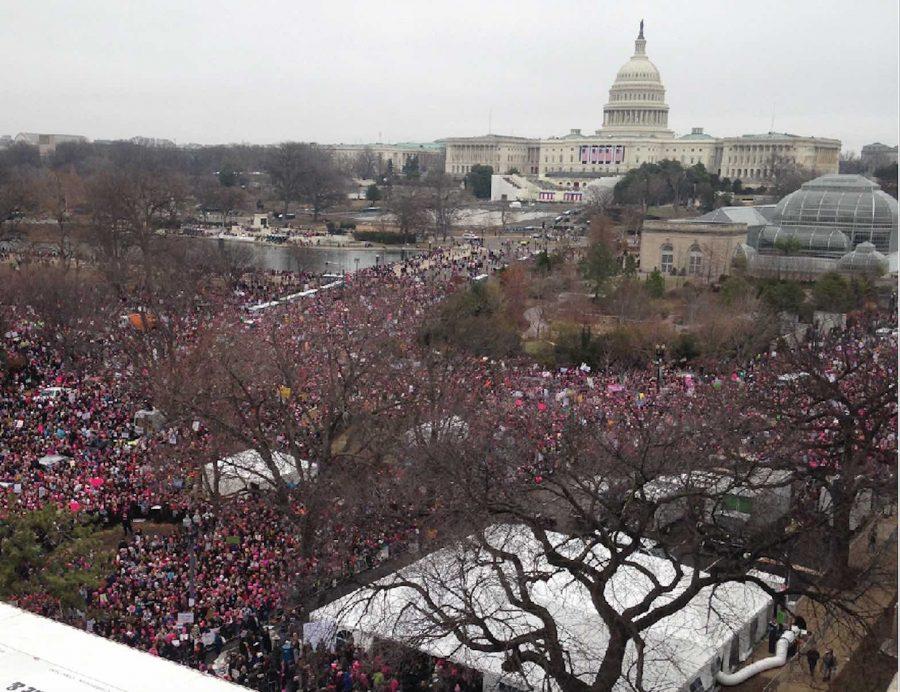Dickinsonians Join Women’s Marches
Jules Struck ’19 / The Dickinsonian
Protestors fill Independence Ave. SW from the Washington Monument to the U.S. Capitol.
At 8 a.m. on Jan. 21, a gleeful cheer reverberated off the walls of the Friendship Heights metro station, where masses of protestors celebrated the approach of an empty train.
Despite the close quarters, protestors who were making the trip into the heart of D.C. for the Women’s March on Washington were in high spirits, and by noon a sea of colorful protestors had clogged Independence Ave.
According to an article in The New York Times by Tim Wallace and Alicia Parlapiano, likely over half a million people trekked into D.C. for the event. Womensmarch.com reports that five million marched in the 673 other marches throughout the world. It was the largest inaugural protest recorded in U.S. history, according to Associated Press.
The march is, as described on the march’s official website, “a proactive international movement, not a U.S. election-specific protest per se, which has galvanized people to defend women’s rights and those of others in response to the rising rhetoric of far-right populism around the world.” The website stresses the importance of inclusivity of people and the promotion of “progressive values.” Speakers at the march addressed a wide range of issues like reproductive rights, LGBTQIA rights, workers’ rights, civil rights, disability rights, immigrant rights, and environmental justice.
The D.C. march and its accompanying “sister marches,” as christened on the official website, drew participants from all over the world. Some Dickinsonians hoisted signs in protest as well, in cities throughout the country including Philadelphia, Boston, and Washington D.C. accompanying “sister marches,” as christened on the official website, drew participants from all over the world.
Students like Caroline Clapp ’19, Mary Emma Heald ’19 and Adeline Murphy ’19 attended Women’s Marches around the U.S. Said Murphy, “I was concerned about the misogynistic and racist statements that Trump made during the election and how they would translate into policies. The huge turnout and energy was uplifting, but my main takeaway was that in order to actually affect the President’s policy decisions we cannot grow complacent over the next four years.”
Professor of American Studies and Women’s, Gender and Sexuality Studies Amy Farrell attended the march in D.C. Farrell was motivated to march because “It’s one thing to allow for an orderly transition of power. Obama did that, and I support that. But it’s another to say that we should be silent in the face of what we are facing.” She continues: “It is our right—as citizens—to protest the government when we see it as wrong.”
“That,” says, Farrell “is the bedrock of our democracy.”
Maia Baker ’19 participated in the march in Philadelphia, which she described as “amazing as well as unprecedented.” She felt a “collective unity and cause” amongst the crowd. Baker added: “it was incredible. We belong in the history books. We are the single biggest movement in American history.”
Stephanie Czmar ’19 was unable to attend the march but also expressed her support, stating, “it was very important for people to be able to come together and stand up for the rights they believe in…While I’m not sure President Trump will care about citizens’ opinions, I hope that other government officials will be influenced.”
Jillian Clark ’19, member of Dickinson College Democrats, marched in Washington D.C., which she described as an “empowering and motivating experience.” She emphasized the importance of maintaining the energy present on the day of the march and the necessity of being “active, inclusive, and fast acting in the coming years” to ensure that the mission of the march is fulfilled.
Speaking as president of the organization, Philip Morabito ’17 affirmed that “the College Democrats supports the mission and conversation that resulted from the Women’s March. We hope that those who participated can mobilize their networks to resist the injustices in our society. It is more important than ever for Americans to let their leaders know where they stand on the issues facing our nation.”
The march has received criticism for its pro-choice agenda and failure to include pro-life advocates. The President of Dickinson College Republicans, Krysti Oschal ’17, echoed these sentiments. As to the position of the group on the march: “Republicans believe that people should be able to peacefully assemble to voice their political views and beliefs without reprisal or fear of personal attacks. However, Republicans also believe that the right to life must be protected, especially the life of the unborn who do not have anyone to speak for them.”
Other critics have questioned the march’s ability to spur real and tangible change. Assistant Professor of Political Science Kathleen Marchetti, whose research and teaching interests include gender, politics and interest groups, suggested that if the activism of the march is sustained, it has the potential to bring about policy change indirectly. She advised that Dickinson students interested in the causes supported by the women’s march participate in the current campaign “10 Actions for the First 100 Days” or become involved with state and local organizations supporting the issues addressed by the march such as Planned Parenthood and the National Organization for Women.






